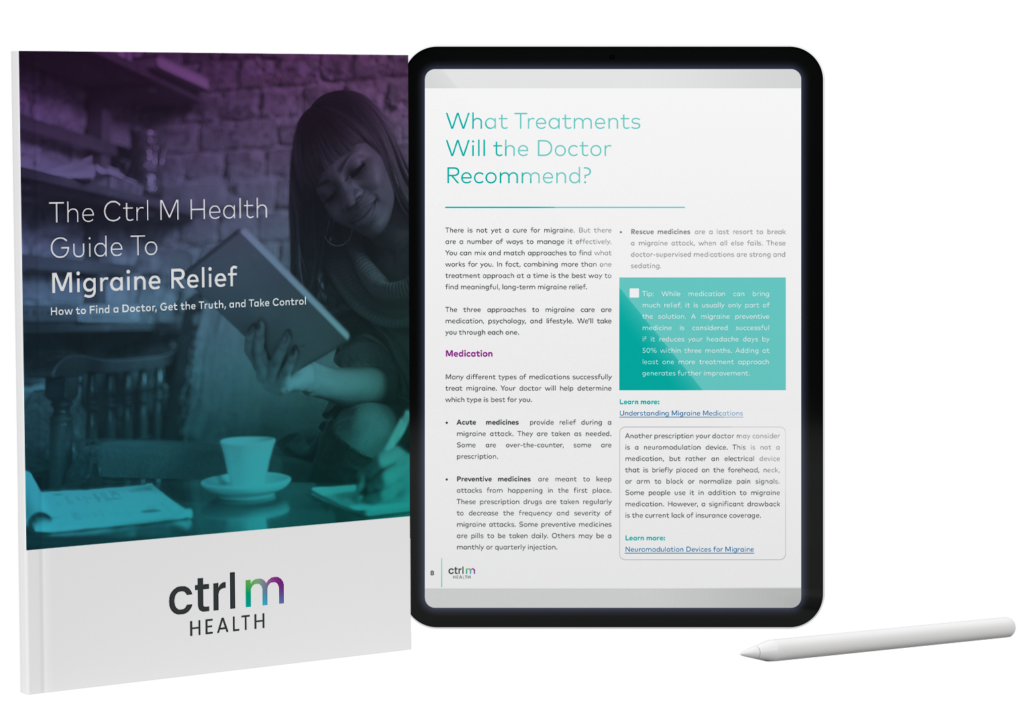If you open a utility box and look inside, you’ll see an array of different tools, each designed for a specific purpose. It’s the same with migraine medications. Different situations require different types of medicines. Some medicines are meant to keep an attack from happening in the first place. Other medicines give you relief once the migraine attack has arrived. Still others are medicines of last resort, for when you need serious help breaking a migraine attack.
Your doctor is your go-to expert to answer individual questions about migraine medications, but here’s an overview of the basics.
Before an Attack: Migraine Preventive Medications
Migraine prevention meds are prescription medications taken regularly (some daily, some monthly, some every three months) to help prevent migraine attacks. Their goal is to decrease your number of days with migraine attacks and/or the severity of the attacks that do occur. Another benefit: Fewer attacks means you’ll need fewer doses of pain relief meds, overuse of which takes its own toll.
Do you need preventive medication for migraine? Consider preventives if:
-
- You have at least one migraine attack per week
- Your medicines for stopping a migraine attack aren’t giving you enough relief or create intolerable side effects
- If you’re taking more pain relief medicine than directed
- You experience debilitating symptoms, such as long-lasting aura, despite taking appropriate migraine-stopping meds
Starting on preventive medicines requires patience and commitment. With an oral medication, a doctor will start their patient on a low dose and slowly increase the dosage. With that gradual approach, it may take up to eight weeks for the medication to begin working. Other medications, such as Botox injections, take as long as six months.
Examples of Preventive Migraine Meds
Many prevention medications for migraine may sound familiar because they were developed for other purposes — for example, to prevent seizure, high blood pressure, depression, or wrinkles. But research has shown they also provide significant benefit for people with migraine. Common preventive migraine medications include:
Beta-blockers: propranolol (Inderal), metoprolol (Toprol), timolol (Blocadren), nadolol (Corgard), atenolol (Tenormin)
Antidepressants:
-
- Nonselective tricyclic antidepressants (TCAs): amitriptyline (Elavil), nortripyline (Pamelor), protriptyline (Vivactil)
- Selective serotonin and norepinephrine reuptake inhibitors (SNRIs): venlafaxine (Effexor), duloxetine (Cymbalta)
CGRP monoclonal antibodies: these new classes of preventive medications are offered under the names Aimovig, Ajovy, Emgality, and VYEPTI
Neuromodulating drugs: antiepileptic drugs, including divalproex sodium (Depakote), gabapentin (Neurontin), topiramate (Topamax, Trokendi)
Neurotoxin: botulinum toxin (Botox)
You and your doctor should consider your medical history and other medications you take to determine which migraine prevention medication is best for you.
During an Attack: Acute Migraine Medications
Acute medicines are those you take as needed to stop or decrease a migraine attack that is underway. This category includes both over-the-counter migraine meds and prescription drugs. Acute meds work best if you take them as soon as the migraine attack begins.
Some acute meds come in nasal spray and injectable forms, which work faster than pills. These formulations are useful if your attacks come on with little warning and ramp up very quickly. They’re also worth considering if during attacks you can’t keep pills down due to severe nausea or vomiting.
Acute medications are very effective. If taken too frequently, however, they create a physical dependence called “rebound headache syndrome,” which actually increases headaches. Limit taking any acute medicine to less than ten days a month. Any more than that, and you may consider adding a preventive medicine to your management strategy.
Examples of Acute Migraine Meds
If you experience migraine attacks, your doctor may recommend taking any of these on an as-needed basis:
Over-the-counter migraine meds: NSAIDs (aspirin, ibuprofen, naproxen); acetaminophen; combination meds (e.g. Excedrin)
Prescription Medications: prescription-strength NSAIDs; triptans (sumatriptan and other meds ending in –triptan); neuroleptics (prochlorperazine, metoclopramide); dihydroergotamine (aka DHE)
New classes of anti-CGRP prescription meds: newly-approved migraine medications include erenumab, gepants (ubrogepant, rimegepant), and ditans (lasmiditan).
The Care Tuner Guide to Migraine Relief
Untreated migraine tends to worsen over time, so if you suspect you have migraine, it’s important to get help. We’ve compiled everything you need, including what to expect, pitfalls to avoid, and what you can do right now to get relief.

When All Else Fails: Rescue Medications for Migraine
Rescue medications are the final options for a severe attack that doesn’t respond to less powerful meds. These are tablets, injections or suppositories that are used only when absolutely necessary, under a doctor’s supervision. They are often sedating and can have significant side effects. A doctor may administer them for three to seven days to break the headache cycle. Your doctor might also recommend you visit an outpatient infusion center or the emergency room for intravenous medication.
Examples of migraine rescue medicine include:
NSAIDs: Toradol (tablet or injection)
Corticosteroids: prednisone (tablet), dexamethasone (tablet or injection)
Neuroleptics: Prochlorperazine (Compazine) or Chlorpromazine (Thorazine)
Intravenous infusions: typically a combination of several medications including DHE, ketorolac, neuroleptics, valproic acid, and/or steroids
Having the right tools in your migraine toolbox gives you the confidence of knowing you’re prepared. If you think migraine medication could improve your life with headache and migraine, consult your doctor for the best plan for you.
The Care Tuner app was established in partnership with the Jefferson Headache Center, designed with your personal health and migraine needs in mind. Download the app today and take a step closer to greater migraine control.





